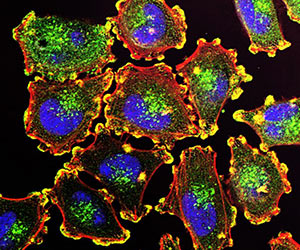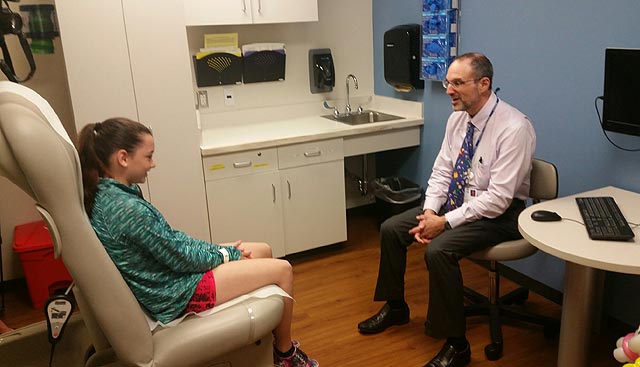Melanoma Research
Melanoma Research in the CoE is directed by Dr. Keiran Smalley, a cancer biologist with extensive experience in developing new melanoma treatment strategies that have been translated into the clinic. Dr. Smalley currently serves on the Scientific Advisory Board of the Melanoma Research Foundation and is also the Scientific Review Officer for its grants program. He is a former Standing Member of the National Cancer Institute’s Molecular Cancer Therapeutics (MCT1) Study Section and has served on the Scientific Advisory Board of the Society for Melanoma Research.
Melanoma research at Moffitt takes place both within individual labs and through four collaborative working groups that focus on specific areas in melanoma research.
The areas of focus for individual researchers include mechanisms of melanoma development, identification of driver oncogenes and signaling pathways involved in melanomagenesis, the role of the immune system and functional studies on the development of melanoma metastases. This knowledge is then leveraged to develop novel targeted therapy and immunotherapy approaches that help inform the clinical trials being undertaken by our colleagues in the Department of Cutaneous Oncology.
Melanoma Working Groups
Brain metastases and leptomeningeal metastases
 The development of brain metastases and leptomeningeal metastases (LMD) are two of the deadliest complications of advanced melanoma. Both targeted therapies and immunotherapies are less effective against brain metastases and LMD than melanomas that grow at other organ sites. CoE members in conjunction with the Department of Neuro-Oncology at Moffitt Cancer Center are providing national leadership in melanoma brain metastasis/LMD research and have innovative new clinical trials open for patients with both brain metastases and leptomeningeal melanoma metastases. In February of 2018, the CoE hosted the second Melanoma Research Foundation Brain Metastases Workshop in Tampa. This meeting gathered over 40 experts from around the U.S. to discuss the latest basic and clinical research on melanoma brain metastases. A number of key recommendations were made and led to the development of a white paper that was published in 2019. The brain metastasis working group (Drs. Forsyth, Duckett, Vogelbaum, Rodriguez, Czerniecki, Macaulay, Pina, Smalley) meets monthly and is addressing some of the key questions that face the field including; how do melanoma cells metastasize to the brain and do we need to develop specific therapies for melanoma brain metastases? The brain metastasis/LMD group has received funding from the National Cancer Institute, the Department of Defense and the State of Florida. Current funding for this group comes from the National Cancer Institute. Several key publications have already emerged from this group including the first-ever characterization of the microenvironment of leptomeningeal metastases and a study defining the immune landscape of brain metastases and leptomeningeal metastases.
The development of brain metastases and leptomeningeal metastases (LMD) are two of the deadliest complications of advanced melanoma. Both targeted therapies and immunotherapies are less effective against brain metastases and LMD than melanomas that grow at other organ sites. CoE members in conjunction with the Department of Neuro-Oncology at Moffitt Cancer Center are providing national leadership in melanoma brain metastasis/LMD research and have innovative new clinical trials open for patients with both brain metastases and leptomeningeal melanoma metastases. In February of 2018, the CoE hosted the second Melanoma Research Foundation Brain Metastases Workshop in Tampa. This meeting gathered over 40 experts from around the U.S. to discuss the latest basic and clinical research on melanoma brain metastases. A number of key recommendations were made and led to the development of a white paper that was published in 2019. The brain metastasis working group (Drs. Forsyth, Duckett, Vogelbaum, Rodriguez, Czerniecki, Macaulay, Pina, Smalley) meets monthly and is addressing some of the key questions that face the field including; how do melanoma cells metastasize to the brain and do we need to develop specific therapies for melanoma brain metastases? The brain metastasis/LMD group has received funding from the National Cancer Institute, the Department of Defense and the State of Florida. Current funding for this group comes from the National Cancer Institute. Several key publications have already emerged from this group including the first-ever characterization of the microenvironment of leptomeningeal metastases and a study defining the immune landscape of brain metastases and leptomeningeal metastases.
Acral melanoma
Acral melanoma is a rare subtype of melanoma that occurs primarily on the hands and feet. It is the most common form of melanoma in patients of Asian and African-American origin. At this time little is known about acral melanoma biology and there are few effective treatments. The CoE acral melanoma working group (Drs. Messina, Smalley, Karreth, Chen, Teer, Koomen) has genetically profiled acral melanoma precursor lesions, used single-cell analysis technologies to characterize the immune landscape of acral melanoma clinical specimens and is currently developing new animal models for the study of acral melanoma. The work has received funding from the Melanoma Research Alliance and philanthropic sources.
Uveal melanoma
Uveal melanoma is the most common cancer of the eye. It is somewhat unique from skin melanoma in having a very low mutational burden and a near-total resistance to both targeted therapy and immunotherapy. The CoE has two active groups working on uveal melanoma. The first, led by Drs. David Morse and Nikhil Khushalani, is focused on the development of new radiochemicals to target metastatic uveal melanoma. This work was funded by the Melanoma Research Alliance and by an SBIR grant from the NIH. The second group focuses on epigenetic deregulation in uveal melanoma and constitutes a multi-institutional collaboration between Moffitt (Drs. Smalley/Karreth), UT Southwestern (Dr. Bill Harbour) and the University of Florida (Dr. Jonathan Licht). This work was funded by a Bankhead-Coley award from the State of Florida and is currently funded by a multi-PI R01 from the National Cancer Institute. A new clinical trial in patients with advanced uveal melanoma has already been developed from this work and is led by Dr. Ahmad Tarhini.

Pediatric melanoma
Although most commonly considered to be an adult disease, melanoma can also occur in pediatric patients. The incidence of pediatric melanoma is rising, particularly in individuals between the ages of 15-19. The majority of pediatric melanomas are sporadic and relatively little is known about their molecular basis. This working group leverages Moffitt’s unique clinical experience (Drs. Sondak, Messina) along with cutting-edge research methods (Drs. Adeegbe, Karreth, Tsai, Smalley, Chen) to delineate the mechanisms of pediatric melanoma development. This work is funded by a pilot grant from the V Foundation and a Live Like Bella Grant from the State of Florida.
Donald A. Adam Melanoma and Skin Cancer Center of Excellence
